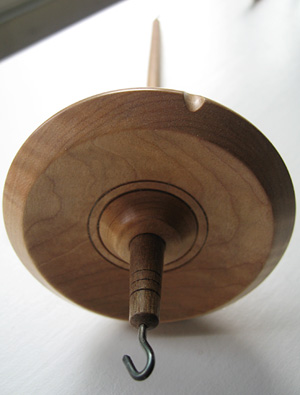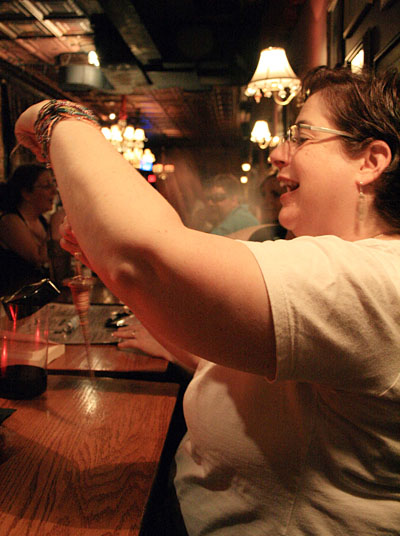This column is about
my journey in learning to spin without wool
or any other 4-legged animal fiber, using the
same tools as everyone else.
I'm not sure what it is about me, but sometimes
I need to be forced to do something before I actually
do it. When it comes to household chores, I guess
that's not so surprising. But when it comes to
trying something I really want to do...what the
heck is my problem?
In this case, what I really
wanted to do was use my handspindles for their
intended purpose. I'd mastered the basics
of
spinning
silk hankies quite a while ago, but spindling
anything slippery -- and most of the non-wool
stuff I spin is pretty slippery -- was just multiple
layers of frustration.
My first spinning lesson was
on a handspindle, and it was a complete failure,
despite the significant prowess and patience of
my teacher. After a day of dropping my brand new
spindle over and over, feeling
more than usually uncoordinated, I gave up the
idea of spindling delicate yarn like the other
big kids. That never stopped me, however, from
continuing to add to my collection of handspindles.
I turned my spinning-training
focus to the wheel, and thanks to my 3-day
course with Maggie Casey at SOAR last
fall, I changed from a timid non-wool spinner wannabe
into someone who could spin fibers like silk, bamboo,
hemp and linen reasonably confidently. Maggie
trained my hands to know what successful spinning
felt like. And as you'll see, this bit of sensory
knowledge proved to be pretty important later on
in a way I never expected.
 |
Norm Hall
convertible spindle in maple, purchased at
the New York Sheep
& Wool Festival, Rhinebeck, NY.
|
Still, something was missing
in my new spinning world, because I still couldn't
spin roving on a handspindle, and I really wanted
to. A lot. The taunting would not stop.
My friend Jillian [also editor
of Knittyspin] and I recently attended the Knitter's
Frolic in Toronto, a massive festival of yarn,
knitting and more yarn, with a little fiber on
the side. There's still room in our stashes for
fiber, so that's what we came home with. As she
always does after getting something fibery and
new, Jillian spent that evening watching Jane Austen
on TV and spindling up her new acquisition. Sexy
silk roving.
I spent the evening watching
Jillian. I'd seen her spindle wool roving before,
but this time, it was silk. She handled the slippery
fibers with confidence and ease, letting the twist
snap into the tiny drafting triangle, creating
beautiful laceweight yarn. What a tease.
I was aching to
do what she did, but remembered how much like a
goof I felt the last time I tried roving + spindle.
I knit instead.
Aching. Interesting choice of words, because that's
what ultimately got me over myself.
I recently was a teacher on a
knitting cruise to Alaska. I went fully armed with
knitting and, just in case the Northern Lights
inspired me, my Bosworth mini and one-ounce twist
of tussah roving in a deep chocolate brown. I'm
still not sure why I packed it.
I knit
and knit happily as the trip began, but soon found
myself in quite serious pain. I'd overdone it on
an impromptu project that required size
US11 needles and super bulky wool-looking-acrylic.
I was miserable, scared I'd wrecked something in
my hand. The needles went
down for the remainder of the trip.
 |
Bosworth mini [pink ivory
whorl, ebony shaft] -- a gift from Jillian,
now wrapped in almost an ounce of laceweight
tussah silk singles...
spun by me.
|
Picture yourself stuck on a big
boat, surrounded by knitters knitting, unable to
knit. Sounds like something Camus would have written,
if he'd been a fiber person.
Digging in my bag, I found the
Bosworth and the roving and, reluctantly, fearfully,
decided this was the time to give it a try again.
For some reason, this time, spinning
silk roving was not a problem. In fact, it was
almost...easy. The spindle dropped, maybe, once.
Just once! I was doing it. The drafting triangle
was my servant. I was making
laceweight silk yarn and it was a piece of cake.
Happily, spinning used different
muscles and tendons in my hands than knitting did,
so it didn't hurt. I was able to spin almost
the whole ounce of tussah before we docked back
in Seattle.
I've continued to practise my
spindling, and had some time to think about
why I finally succeeded. I think it comes back
to Maggie's training of my hands, maybe a little
channeling of Jillian's skill [a lot of watching
might have helped some of the techniques sink in]
and mostly just being brave enough to try even
though I was sure I'd probably fail.
I'm self conscious about learning
new stuff. I know a learning curve is part of the
deal, and am an evangelist to my students about
not beating yourself up as you learn in the knitting
classes I teach.
But I guess I'm extra
sensitive to that feeling of trying something new
and being a mess at it. My first [and last] time
waterskiing, now that I think of it, is an awful
like my first attempt with that Cascade spindle
several years ago. I was in the seated position,
skiis in front of me, hanging on to the tow rope
between my legs like I was hanging from a cliff.
The boat took off and boom, I performed a perfect
faceplant in the water. That one try was enough.
I spent the rest of the day on the dock, watching
the other campers do infinitely better than I did.
If I can't get even a basic grasp
of the thing, a hint of what success might feel
like, my temperament doesn't encourage me to keep
going. I'd rather just watch.
 |
Happily spinning silk and
seacell roving on a Golding 2" at the
Tip Top bar in Columbus, Ohio, surrounded
by knitters and spinners.
Photo courtesy of the fabulous Miriam
Felton.
|
When it came to spinning, however,
Maggie had taught me the first foothold that strengthened
with every new technique I tried. Success encouraged
me to be brave enough to drop my beautiful Bosworth
[the floor was carpeted anyway] and possibly look
like a goof in front of a room full of spinners.
Learning to spin on a wheel
was a big, big deal to me. I thought that would
be enough to satisfy my urge to spin, but that
foothold just made my lack of even basic spindling
ability an embarrassment to me. I was tired of
using "my fibers are
too slippery" as an excuse.
Now that I can pull out my handspindle
and a small bag of silk and seacell roving and
spin a little while waiting for my plane, or sitting
at a pub waiting for the drinks to arrive, I feel
quiite powerful. I'm not shy about it any more.
I'll spin anywhere, in front of anyone. The feeling
I get as the yarn builds into a tidy cop on the
shaft rivals even the giddy joy of the first heel
I turned in a sock. Handspindling was, I thought,
out of my reach. Instead, all I needed was to get
over myself and just DO it.
But I'm still not trying waterskiing
again. |

